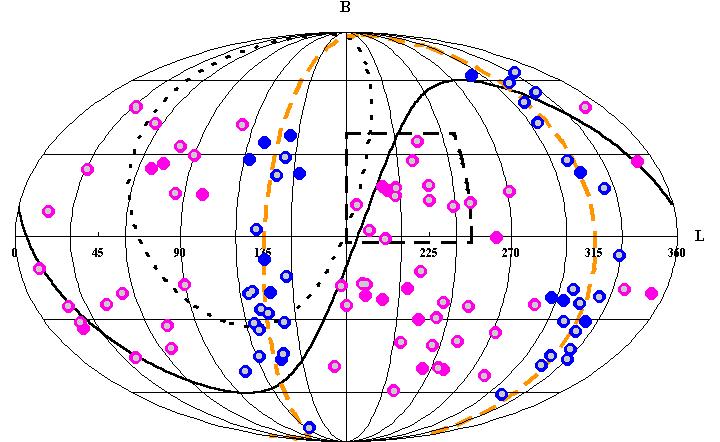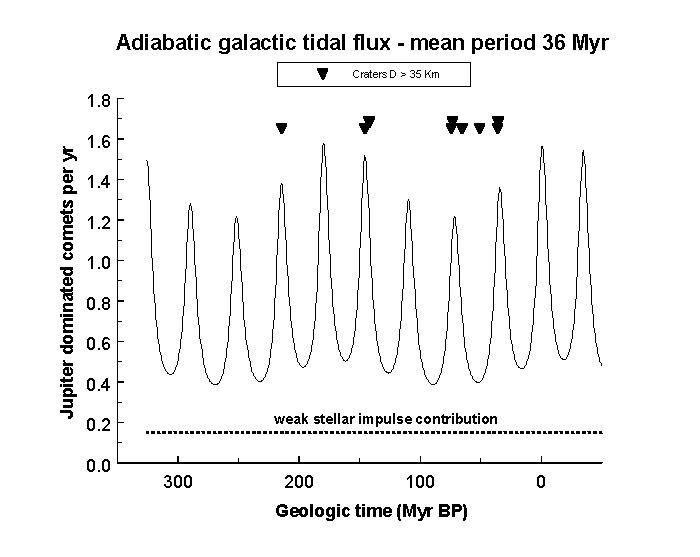

John J. Matese
Emeritus Professor of
Physics
University of
Louisiana at Lafayette
Research Interests

The bulk of my recent research activity has centered on the Oort comet cloud. In particular, the distributions of observed orbital elements can differ from the in-situ distributions because of observational selection effects and observational uncertainties. Of more interest dynamically is the imprint of the physical mechanism responsible for making these comets observable. To make a comet observable its perihelion distance, q, must be reduced to sufficiently small values that the solar insolation will create a detectable coma. Since the angular momentum of a near-parabolic orbiting Oort cloud comet is proportional to q1/2 , to reduce q we must reduce angular momentum, and the tidal torque of our Milky Way Galaxy is the dominant mechanism for doing so. Specifically, we argue that the tidal torque due to the smoothed matter density of the galactic disk leaves its own signature on these Oort cloud comet orbital element distributions. Thus ``what you see is not what you've got out there``. In a presentation at the DPS 2003 meeting in Monterey, we provide the most recent evidence that the data are of sufficiently high quality, sufficiently free of observational bias and sufficiently numerous to clearly detect subtle imprints of the galactic tide. Objections of this sort are often raised, but seldom supported with analysis, when the data are used to infer dynamical mechanisms making new Oort cloud comets observable. DPS2003 Monterey Talk:
The related paper, done in collaboration with J. J. Lissauer, has been published Icarus Paper of Monterey Talk:
A substellar solar companion in the Oort cloud?
The following figure illustrates the scatter on the celestial sphere of outer Oort cloud comet aphelia directions in galactic coordinates. The pronounced deficiencies at the galactic equator and at the galactic poles are characteristic of the galactic interaction which is minimal at these locations. But we also note an anomalous concentration of points along a "great circle" which passes near the galactic poles. In a pair of articles in the journal Icarus, we have suggested that there is statistically significant evidence that this concentration, amounting to an excess of approximately 25%, could be caused by a companion to the Sun which aids the galactic tide in making Oort cloud comets observable. The companion is estimated to have a mass of 1-4 MJupiter and a mean distance at the interaction site of 10000-30000 AU. Its location along the great circle is not presently predictable. An object with these properties would have been recorded in the WISE preliminary catalog (Ned Wright's Wide-Field Infrared Survey Explorer). The estimated mass of the companion puts it below the nominal brown dwarf limit (~ 13 MJupiter ) where deuterium fusion can occur and would make it a planet in that context. However its location in the outer Oort cloud means that it is not possible that it formed in the protosolar planetary disk. The object could have been ejected from another stellar system and captured by the Sun in their complex star forming region. Links to the Icarus paper on the evidence supporting the original conjecture, and a recent Icarus paper describing the persistence of that evidence are found below.

Aphelia scatter of "new" comets (original semi major axes a>10 000 AU) with well-determinined orbits (Class I ; 14th Catalogue of Cometary Orbits, 2001) in galactic coordinates.
Icarus 141, 353 (1999) reprint on a putative companion to the Sun
ACM 2002 Berlin Talk:
"Continuing Evidence of an Impulsive Component of Oort Cloud
Cometary Flux"
new Icarus 2011 paper on Solar Companion
Lille Observatory 2011 invited presentation
EPSC-DPS 2011 Nantes contributed presentation on searching WISE catalog for an ultracold planet
Detaching Sedna by a solar companion in the Oort comet cloud
Morbidelli and Levison (2004 AJ 128, 2564) consider
various scenarios for the origin of the orbits of Sedna-like
objects, which are deeply imbedded in the inner Oort cloud. The
only ones which they find to give satisfactory results is the
passage of a low-velocity solar-mass star at about 800 AU during
the early solar environment, or the capture of extrasolar
planetesimals from a low-mass star or brown dwarf encountering
the Sun. They observe that creating ``extended scattered disk
objects" (in which the largest orbits also have the largest
q) requires a perturbation ``from the outside", but do not
discuss the possibility that the external perturbation could come
from a Jovian-mass wide-binary solar companion. We investigate
the parameter space of such an object which would adiabatically
detach Sedna from Neptune's dominance with initial orbital
parameters qS (0) ~ 35 AU, aS = 489 AU to
its present perihelion value of q=76 AU. Results of this work,
done in collaboration with D. P. Whitmire and J. J. Lissauer,
were discussed at the 2004 DPS meeting in Louisville
Power Point version:
html version: and
also at ACM 2005 at Buzios BR. Preprints are available at ACM 2005 Proceedings Paper
(Earth, Moon, Planets (2005)). A more
detailed analysis of this conjecture, done with colleagues Rodney
Gomes' and Jack Lissauer, is now in print Icarus 184
, 589-601 (2006).
A companion capable of detaching Sedna could
have a mass of ~ 3 MJupiter and a distance of ~ 8000 AU in the early solar system, while being promoted
to the larger orbit consistent with the present perceived Oort cloud anomaly.
Characteristics and frequency of weak stellar showers of the outer Oort comet cloud
We have initiated a study of the characteristics and frequency of weak shower of outer Oort cloud comets caused by a stellar impulse. This work is done in collaboration with Jack Lissauer at NASA Ames Research Center. The main objective is to study the predicted details of the orbital element distributions which would occur in a stellar weak shower (defined as one which is dominated by the galactic tide, but assisted by the stellar impulse) and to contrast the distributions with those obtained by the galactic tide alone. A future goal is to contrast the predictions for a stellar impulse+galactic tide with that for a bound companion+galactic tide. The paper is now published, Icarus 157 , 228-240 (2002)
Time dependence of the tidal induced Oort cloud comet flux
Since the galactic tide dominates in making Oort cloud comets observable today (and is also likely to do so when averaged over long time scales) we can inquire about the long-timescale variability of the tidal interaction which is connected to the solar oscillation about the galactic midplane. Below we show a modeled time dependence of the flux which is most consistent with the occurrence of large craters. Shoemaker has argued that the largest craters are dominated by long period comets originating in the Oort cloud. Still being debated is the actual period of the oscillations. Only if the long term average of the midplane crossing period falls in the range 34-37 Myr would this hypothesis be viable. A no-dark-disk model would yield a period of ~ 45 Myr. There must be modest amounts of compact dark disk matter distributed over scale heights of ~ 50 pc if the tidally produced modulation of the Oort comet flux is indeed the cause of substantive periodic modulation of large crater formation.
In a review paper recently published ["Variable Oort Cloud Flux Due to the Galactic Tide", in "Collisional Processes in the Solar System", Astrophysics and Space Science Library, Eds. M. Marov, H. Rickman , Vol. 261 91-102 (2001) J. J. Matese, K. A. Innanen and M. J. Valtonen Assl (pdf) paper ] this topic is discussed in detail. Recent Hipparcos data (Holmberg and Flynn, MNRAS 2000) indicates that there is no evidence of significant amounts of compact dark disk matter in the local region of the Milky Way disk If this result is also applicable to the solar vicinity of the galactic disk during the past 225 Myr, then we must conclude that even though there is substantial modulation of the Oort cloud comet flux over long timescales, it will not manifest itself in the cratering record.

Time dependence of the Oort cloud comet
flux. In this modeling the weak stellar impulse contribution is
taken to be constant and modest amounts of CDDM are included to
reduce the average plane crossing period to 36 Myr from its no
DDM value of 45 Myr. This results in a best fit with observed
large crater formation.
Some references to relevant papers (co-authored variously with colleagues P. G. Whitman, D. P. Whitmire, J. Q. Zheng, M. J. Valtonen, K. A. Innanen, R. S. Gomes' and J. J. Lissauer) detailing the Galaxy-Oort cloud connection, its time dependence, and various other aspects of Oort cloud comet dynamics, including the companion conjecture, are listed here. Complete details are found in the vitae. JJM Vitae
UL Lafayette Department of Physics This page last changed on 21 September 2011 | UL Lafayette |
The Matese Family: Left to Right
Sharon, Gabrielle, Claire, Mary, John J., John C.
